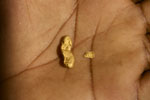
NAIROBI, Kenya — We are one step closer to a conflict minerals certification process. In a conference that facilitated breakthrough dialogue, the 11 countries of the International Conference on the Great Lakes Region, or ICGLR, donors, industry leaders, and NGOs met here last week to hammer out standards for an international certification scheme for tracking conflict minerals from Congo and its surrounding countries.
The mechanism would also coordinate with multinational industries to trace the flow of those minerals through global supply chains, through coordination with the Organization for Economic Cooperation and Development, or OECD. The conference, organized jointly by the OECD and the ICGLR, was a significant step forward in garnering the cooperation necessary to create a credible certification scheme for conflict minerals being extracted from Congo.
Delegates at the conference believed that higher-level political engagement from the United States, in partnership with the region's political leaders would help steer the scheme through. The U.S. is currently being seen as providing the stick to this process because of the Congressional legislation's potential threat of a minerals embargo. Executive leadership would reverse this perception by advancing real certification and prove to the region that the U.S. is committed to addressing the conflict minerals problem.
The key stakeholders at the meeting focused deliberations on bringing together the existing due-diligence strategies developed by the ICGLR, OECD, and industry trade groups such as the Electronics Industry Citizenship Coalition, or EICC, the International Tin Research Institute, or ITRI, and the Tantalum-Niobium International Study Center, or TIC, to harmonize efforts and create a central framework for regional certification and international supply chain monitoring. If adopted this framework would apply to companies from all 33 OECD member states as well as to mineral extraction companies from the 11 ICGLR states. Regional governments with international stakeholder support agreed at a ministerial level to accept the joint OECD-ICGLR guidelines, which resulted in a signed agreement on the final day of the meeting. The document laid out four key principles for developing a regional framework to stem the conflict mineral trade:
- The harmonization of mining and mineral transport laws
- The formalization of the mining sector
- Increased transparency
- The creation a regional database to trace the origin of minerals for export
The process will now move to final deliberations, culminating in November when heads of state will meet at a summit in Kinshasa to formalize the ministerial agreement.
In the wake of the new U.S. law on conflict minerals which establishes supply chain due diligence requirements for companies that are publicly traded in the U.S. that use any of the 3Ts (tin, tantalum, tungsten) or gold, the creation of this regional certification scheme could be a huge step in ensuring companies, governments, NGOs, and advocates can confidently trace minerals from mine of origin to end-use consumer products. The ability to create a more transparent supply chain will be critical in identifying those companies or actors that contribute directly or indirectly to funding armed groups committing illegal acts in the Congo, and choking them off from international financial support. Incentivizing legitimacy, and keeping an international spotlight on the illicit actors in Congo’s mineral trade will be a primary component of any comprehensive strategy to reduce the continuing and rampant violence and sexual assault in Congo.
However, as the process for regional certification begins to take shape, it will be necessary to involve local civil society more closely in the process. Access to this information is difficult to obtain because civil society groups in Congo and some neighboring countries are often afraid to raise their real views in public for fear for their personal safety. It will therefore be essential that this process be as inclusive and transparent as possible to gain credibly.
Moving forward it will also be imperative that the U.S. and other international governments support the ICGLR countries in their bid to develop a regional conflict mineral certification scheme. Given that the minerals extracted from Congo are primarily used in western consumer products and that initiatives to curb the violence in Congo through creating due-diligence standards have been propelled forward by U.S. legislation, it is inherently the responsibility of the U.S. and other western nations to be key partners in the support and implementation of the process. The special summit in Kinshasa this November provides a useful window for U.S. engagement.
Brokering international agreements among such diverse sets of stakeholders is clearly no easy task. However, the progress made in the past year by governments, industry, and NGOs to develop a system to trace, audit, and certify conflict mineral supply chains from Congo is commendable. All sides have made concessions, and agreement seems within reach.
The need for a credible, reliable, and sustainable process has never been more stark. Concerned NGO and civil society groups hope that transparency and inclusiveness will be ensured and that the end goal of the reduction of systematic violence and sexual assault in the Congo will remain at the forefront of any final agreement.
Photo: Gold in the hand of a trader (Enough/Sasha Lezhnev)

